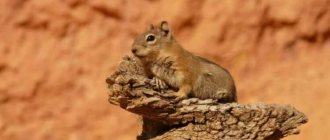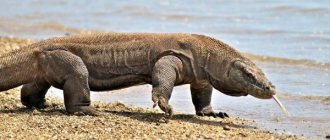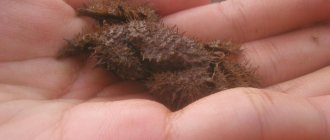There are more than 40 thousand species of spiders in the world, which differ in size and color, but in appearance they are all almost the same. Among such a variety of species, there are both very small spiders and large ones, reaching 10 cm in size, or even more. If many species eat small insects, then there are species that feed on small rodents, birds, etc. Some species pose a mortal danger to human health due to their strong poison. For those who are planning to visit hot countries, it is advisable to know what the largest spiders in the world look like.
Nephila goldweaver
Nephil the golden weaver occupies tenth place in the ranking. The spider got its name thanks to its web. When the sun's rays fall on it, you might think that it is woven from golden threads. During the weaving process, the spider is able to change the color of the pigment of the threads, making it less noticeable to insects in dark or light areas. The strength of the web allows you to catch birds, bats and even snakes. The thread contains a chemical compound designed to repel ants.
Only female individuals weave a strong web with a golden hue. These spiders are prone to sexual dimorphism; females are almost 5 times larger than males in size. The limb span of females reaches 13 cm, and the total length of the male is only 2.5 cm.
Spider venom is toxic, but not fatal to humans. There may be redness and pain at the site of the bite.
It lives in warm regions of the planet - South America, Australia, Asia, Africa and Madagascar. Hides in forests with sandy soil.
Interesting: Fishermen use the nephil web instead of a fishing net, it is so strong.
South Russian tarantula
The giant spider belongs to the wolf family. Hunts insects, beetles, caterpillars. Their homeland is Asia, they live everywhere, found in Russia and Ukraine. The body is gray-black, covered with dense hairs. Size about 3.5 cm. Lives in burrows underground and tree hollows. Rarely appears outside, attacks from its secluded place. The web is weaved at the entrance to the burrow, and also to form a cocoon for the larvae.
The South Russian tarantula bites people when there is a threat to its own life. Swelling, pain, and redness appear at the site of the attack. Children and people with weakened immune systems experience weakness, headache, nausea, and dizziness.
The largest spiders in the world
Tegenaria wall
Tegenaria or house spider is a large spider that lives in human homes. Listed in the Voronkov family, its networks resemble the shape of funnels.
The legs of Tegenaria reach an average of 10 cm, and the size of the body is several cm. As a result, the full size, taking into account the span of the legs, can reach an impressive 15 cm. The color of the body is dominated by light brown shades, and the limbs are covered with dark stripes. Adults have several black stripes on their backs.
The house spider likes to hide under tree bark or fallen leaves. This species of spider is considered harmless. It is not capable of causing serious harm and is not poisonous.
Extinct giants
Spiders have lived on earth since prehistoric times. Scientists are sure that in former times these creatures grew to sizes that cannot be compared with the listed heroes of today's rating.
The logic of the researchers is clear: if the victims of spiders reached gigantic sizes, then the predators themselves must be large, otherwise they would not survive. But the complication is that fossils of giant dragonflies or other insects have long been found, but less luck with extinct spiders.
The fossil spider Nephila jurassica was only recently discovered. The remains were found in China, in the Jurassic deposits of the Inner Mongolia province. The span of the limbs of the ancient creature exceeds 15 cm, the body size is 3 cm. Paleontologists have established that the arachnid lived 165 million years ago.
View this post on Instagram
A post shared by Victor Ray (@v1cr4v)
Nephila jurassica
The spider found under layers of ash was female. Females are much larger than males. Scientists are confident that they will be able to thoroughly examine the remains of a prehistoric arachnid, because volcanic ash preserved its body, protecting it from damage and decomposition for thousands of years - such preservation is not usually found.
It is certainly not the largest spider in history, but it is considered one among the fossils, since the remains of larger individuals have not yet been encountered.
Brazilian wandering spider
The Brazilian wandering spider is always on the move and does not spin a web, which is why it got its nickname. It can be found in southern North America and southern Central America.
During the daytime, it hides under stones and fallen logs, in bromeliads and plants of the banana family. In areas with high population densities, it can be found in boxes, clothes, shoes, near homes and even in cars.
The total length reaches 17 cm, and the length of the body is 5–7 cm. The color is in light brown shades with light patterns in the belly area. There are thin dark stripes on both sides of the head, a dark stripe in the middle of the cephalothorax and several dark stripes on the front legs.
It is one of the top 10 most poisonous spiders; its poison is dangerous to human life. Serious consequences can be avoided by immediately going to the hospital.
Interesting fact: The spider loves to eat bananas, which is why it received the nickname banana spider.
Common salpuga
According to a survey conducted in the United States, the common salpuga is considered the most creepy and disgusting spider in appearance. It can be found in Central Asia, in the desert and open areas of North and South America.
In fact, salpuga (bihorca or phalanx) is not an arachnid. It was classified in this category of arthropods only because of the presence of chelicerae and the structure of its legs. The ends of the legs are equipped with mini-claws, with which they grab the victim and hold them until the poison begins to act.
All representatives of the common salpuga are characterized by increased aggression. Moreover, they show it not only in relation to the enemy, but also towards each other. Phalanges are especially dangerous during the mating season. The female spider can attack at any time and attack with her legs, even if no one touched her.
Today, science knows more than a thousand varieties of common salpug. The largest representatives of this species are the harvester Phalangida. The size of its body exceeds 10 centimeters, but it cannot boast of long legs. They are very short but powerful. The smallest spider from the salpug family is Chelypus eberlanzi. It is three times smaller than the Phalangida harvestman.
A phalanx bite is extremely dangerous to human life. The victim has only 20 minutes to see a doctor, otherwise blood poisoning begins and the patient dies within 24 hours.
Cerbal Arabian
Cerbal Arabian was discovered by zoologists in Israel relatively recently, hence its name. The spider prefers a nocturnal lifestyle, which is why it was not discovered before and very little is known about it. Habitat: deserts.
The total size of the spider with outstretched legs reaches 20 cm. Males are always smaller than females. The color camouflages it for existence in sandy conditions, it is usually pale yellow or beige in color, with black spots on the legs.
It is not dangerous for people.
You can also read on our website which is the largest rat that lives on our planet.
Giant baboon spider
This giant spider got its name due to the similarity of the shape of its legs to the limbs of monkeys. Member of the tarantula family. Lives in tropical forests and subtropics. Because of its habitat, it is often called the African tarantula.
The limb span reaches 20 cm, and the total length reaches 30 cm. It is found in tropical forests and belongs to a burrowing species. It has a red-brown color with shades of orange. The paws are covered with shaggy hairs.
It poses a danger to humans with its poison, but never attacks first. When defending, it hisses like a snake, knocks with its front legs and stands on its hind legs, pretending to look intimidating. The spider is active at night. He hunts crickets and butterflies, small mice, and does not disdain his relatives.
Indian ornamental tarantula (Poecilotheria regalis)
Leg span - up to 18 cm.
Indian ornamental tarantula (Poecilotheria regalis)
This beautiful large spider lives in the tropical forests of southwest India. Settles in the crowns of trees. Finds refuge in the voids of the bark and between the branches. Young individuals live on the ground. Sometimes small holes are dug, on top of which a “room” is built from a mixture of cobwebs and earth.
Like other tarantulas, they do not build trapping nets. They hunt mainly at night; they sense the approach of potential prey with tactile bristles on their legs.
Very fast and aggressive. But if a shelter is nearby, they will prefer to hide in it. The bite is toxic and can pose a health hazard. Possible consequences include: severe pain, numbness, breathing problems, atrial fibrillation, and complete or partial paralysis of the bitten limb. All symptoms disappear after 1-2 days, but may recur after 2-4 weeks or more. No deaths were recorded.
Purple tarantula
One of the largest spiders in the world is the Colombian purple tarantula spider. Belongs to the tarantula family. Lives in tropical rainforests of South America.
The body measures 9–11 cm, and together with the paws reaches a length of more than 34 cm. The body and paws are covered with dark velvet-like hairs, the hairs are thicker towards the base of the paws, which allows it to move both on rocky surfaces and soft soil.
It feeds not only on birds, but also on various rodents, amphibians and insects.
Interesting fact: Its furry cover and interesting color attract the attention of spider lovers. The tarantula is often kept at home. However, the spider is extremely aggressive, contact with it can cause an allergic disease.
Costa Rican red-footed tarantula (Megaphobema mesomelas)
Paw span: up to 15 cm.
Costa Rican red-footed tarantula (Megaphobema mesomelas)
The Costa Rican red-legged tarantula is a very large, beautiful spider. In nature, it can be found in the mountain forests of Costa Rica at an altitude of up to 2.5 km above sea level. Humidity and coolness reign there (18-24°C). The tarantula uses a variety of shelters and often digs holes up to 1.5 m in length.
Megaphobema is known for its aggressive temperament and unusual defensive behavior. In the event of a real (or imaginary) threat, it begins to scrape off dangerous hairs from the abdomen with its chelicerae and jumps to a height of several centimeters to scare away the predator. If this does not help, he resorts to a secret weapon: he begins to spin, and when his back is to the enemy, he tries to hit him with his sharp spikes on his hind legs. Poison is used only as a last resort.
During reproduction, these spiders behave very aggressively. It rarely comes to murder, but after foreplay the “spouses” may be left without several paws.
Costa Rican red-footed tarantulas are kept in home terrariums. They are not recommended for beginners.
Camel spider
The camel spider has many alternative names, such as bihorca, salpuga or phalanx. It is part of the order Solifugae, which is Latin for “sunlight runner.” However, this does not mean at all that he is afraid of the sun. Among the species from this order there are many sun-loving arachnids. Lives in the deserts of most continents.
The spider's paw span is up to 30 cm, and its body size is 8 cm. The color is brown-yellow, closer to orange. The limbs and body are covered with hairs, and tentacles protrude from the front.
Prefers night time, hunts lizards, mice, chicks, beetles and some other animals.
Theraphose blonde
The largest spider, a member of the Theraphosa blondi species, was found in early 1965 in the forests of Venezuela. The span of its front legs is 28 centimeters. Listed in the Guinness Book of Records. In 2001, a representative of the spider family Sparassidae was discovered in the vicinity of the capital of Laos. According to notes and pictures in the scientist’s personal diary, the span of its paws was 30 centimeters, but this could not be confirmed, because no one had seen the spider itself.
It is worth noting that Theraphosa Blondie, found in Venezuela, is not such a revolution in the field of arachnology. All individuals of this species are large in themselves. The body of females on average reaches 90 mm in diameter, while in males it is 4-5 mm smaller. The span of the front legs of spiders ranges from 25-27 cm. They are covered with thick hairs of a red-brown hue.
You can meet Theraphosa blondi in the forests of Suriname, in the bushes of northern Brazil, in the vicinity of Paramaribo (Guyana) and in Venezuela. Spiders are not poisonous, but have large jaws that easily bite through human skin and inject a weak poison that causes temporary numbness of a limb or area of soft tissue.
Pink tarantula spider
The pink-haired tarantula is what it is called in the northern Atacama Desert. It lives in the territory from northern Chile to the southwestern United States. It is also called the Chilean - fiery or orange tarantula.
The body size of the tarantula reaches 10 cm, and the leg span is 30 cm. The color with pink shades is not the only one; the Chilean tarantula also stands out with red-brown shades. The hairs on the body are pink. Females are larger than males, their body weighs about 100 grams, and males boast rather long legs.
The tarantula attacks its prey with lightning speed, leaving no chance. In defense, he shakes off allergenic hairs that contain poison and raises his front paws. Its poison is not dangerous to people, but can cause allergies and burning.
Brazilian black and white tarantula
Despite the fact that this arthropod is quite aggressive, this species is not dangerous to humans.
If a Brazilian black and white tarantula does bite, you may develop an allergy to its venom. But this is not necessary; even the person may not feel anything.
The leg span of this spider reaches 23 cm. This species lives in Brazil.
Giant crab or spider hunter
The long and curved limbs that resemble a crab are the reason for its name. The arthropod lives in Australia.
The size of females reaches 30 cm, males are one and a half times smaller. It has several types of color ranging from light gray to dark brown. In the photo you can clearly see the powerful jaws.
Unusual legs allow it to crawl into cracks, quickly climb trees and move sideways. The crab spider runs fast and jumps high. Its bite is not dangerous for humans, but irritation and discomfort may form at the site of the bite.
Heteropoda Maxima - the longest-legged spider
The Goliath tarantula can rightfully be called the largest spider in the world, based on the size of its body and weight. However, it will compete with the giant hunting spider, or Heteropoda Maxima, which has the longest leg span. This figure for an adult male of this species can be 25-30 centimeters!
These spiders live mainly in Laos, preferring deep and dark caves, from where they rarely come to the surface of the earth. Their bodies, relatively small in size (up to 3 centimeters in males and 4.5 in females), are colored brown-yellow, the abdomen is somewhat darker than the cephalothorax.
Today, science knows very little about them, but they continue to be studied.
Goliath tarantula
The Goliath tarantula takes an honorable first place in the top 10 largest spiders in the world. This is the largest and most terrible spider on earth, the largest species of tarantula.
The weight of the largest spider on the planet is about 200 grams, the leg span reaches 30 cm, and the body size is as much as 12 cm.
The color of the largest tarantula is brown and all its shades; in the mouth there are large fangs with poison, measuring 3 cm or more. The paws have reddish hairs and transverse white stripes. Hides in damp and deep holes.
The largest species of this tarantula was listed in the Guinness Book of Records, the span of its limbs was 28 cm. This giant lives in the lands of South America.
During a hunt, the tarantula attacks the victim with lightning speed, grabs it with its predatory teeth and sheds hairs with paralyzing poison. It chooses insects, rodents and amphibians as victims. Despite the name, it rarely touches birds.
Goliath is practically not dangerous; its venom can cause the development of allergic reactions and severe pain at the site of the bite, due to its giant fangs. When defending themselves, they can stand on their hind legs and shoot at the offender with their spiky hair. Hairs can get stuck in the skin and cause irritation.
Giant tarantula from Sri Lanka (Poecilotheria rajaei)
Leg span – up to 20 cm.
Giant tarantula from Sri Lanka (Poecilotheria rajaei)
This tarantula was first discovered in 2009, when a villager brought a dead spider to a research organization in Sri Lanka. A team of scientists was assembled to study the new species. During the expedition, they were accompanied by police officer Michael Rajakumar Purajah, after whom the spider was named.
A huge poisonous spider lives in trees. Several individuals were found on the premises of an old hospital in Mankulam.
According to Australian arachnologist Robert Raven, the tarantula discovered in Sri Lanka may be just a local variety of the already known species Poecilotheria regalis, which is found in mainland India.











